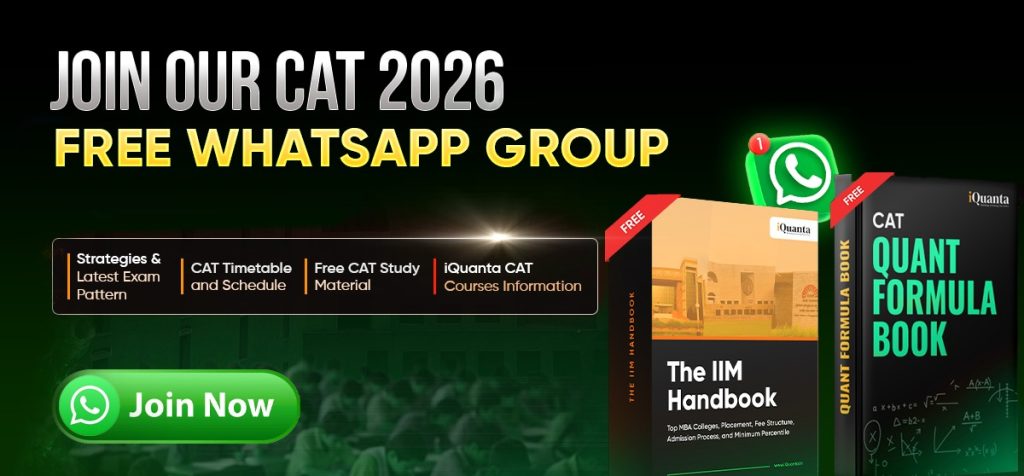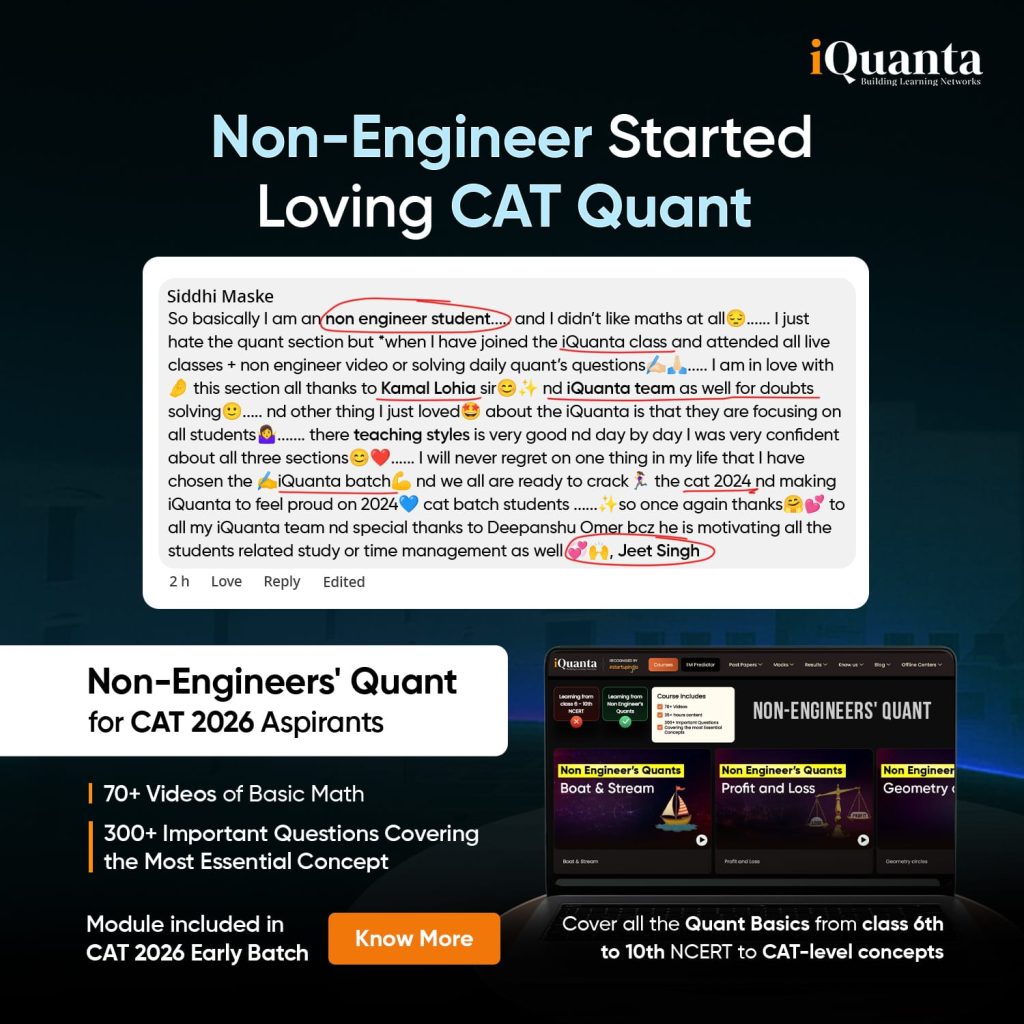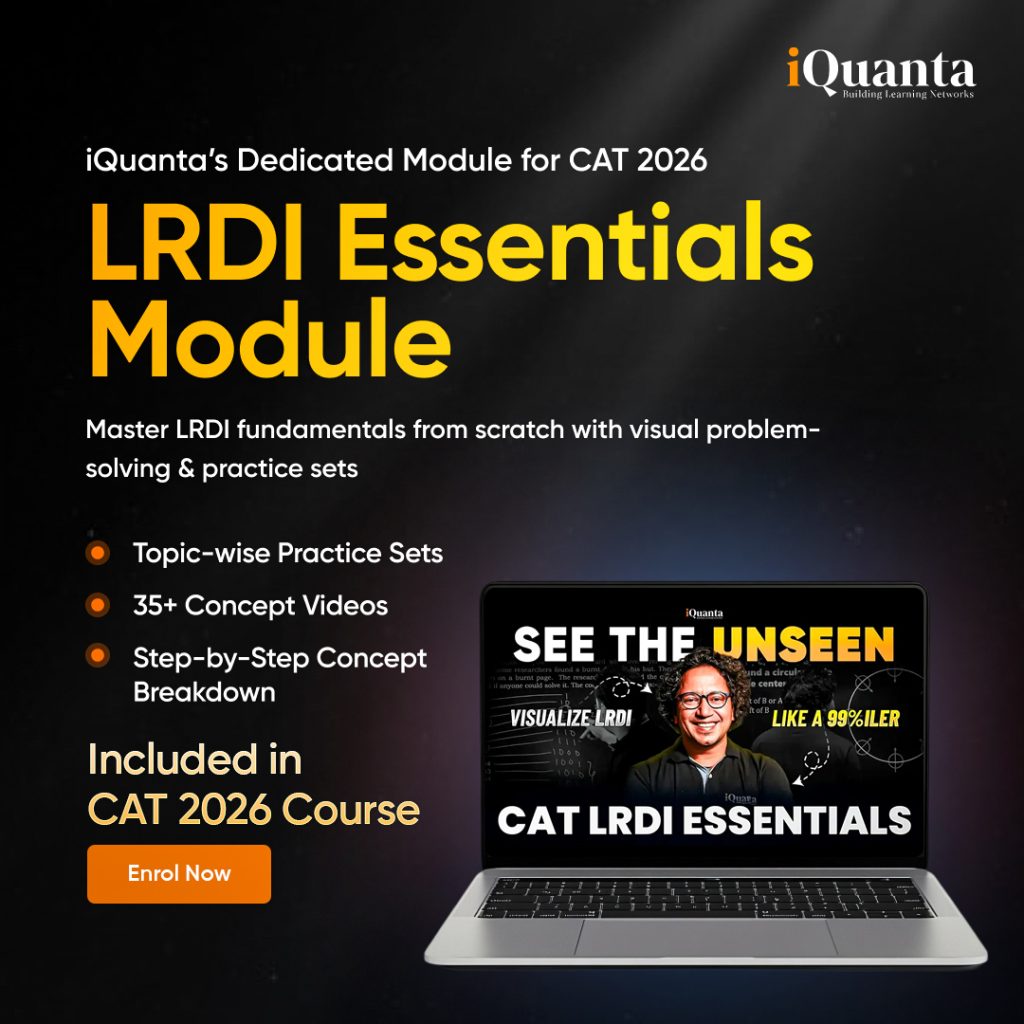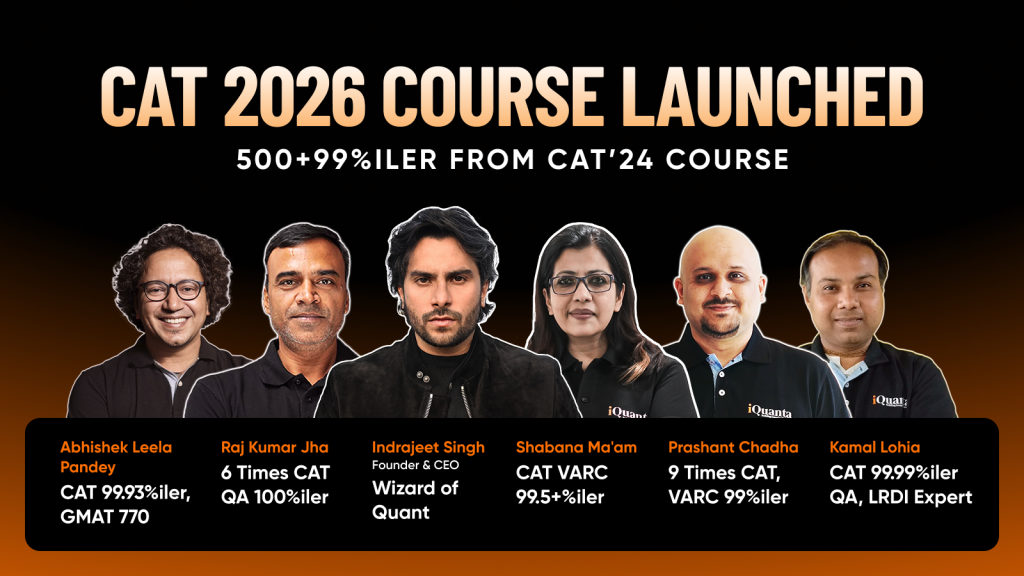There are only 400 days left for the CAT 2026. Primarily, the CAT (Common Admission Test) allows candidates from diverse backgrounds to appear for this popular MBA entrance exam. The syllabus is mainly divided across 3 different sections,i.e, Quantitative Aptitude, Data Interpretation and Logical Reasoning, Verbal Ability and Reading Comprehension. Since there are students from different streams, we believe that everyone will have a different preparation strategy. Basically, the CAT 2026 Preparation Strategy for Non-Engineers and Engineers will be different.
In this comprehensive blog, we will be sharing a detailed outline to create a well-balanced preparation plan. Aditya Gupta (CAT 2024-99.75%iler) will share his personal experience about the CAT preparation. He will also explain to you about the resources that you can refer and solve the questions from every section. This will simplify your preparation roadmap for the CAT exam, which will eventually help you to outshine as the 99.99%iler in 2026.
Join this free WhatsApp group to get the latest information about CAT exam along with the strategies by CAT experts

What Should Be the CAT 2026 Preparation Strategy for Non-Engineers?
Being a non-engineering candidate, Aditya Gupta states that CAT is not about completing each and every topic. It’s about how strong your basics are and what strategies you’re following to solve the CAT-level questions. Talking about Aditya’s previous academic qualifications, he’s a BBA Graduate who appeared for the CAT 2024 and successfully scored 99.75% in the entrance exam. This score helped him convert to IIM Indore and IIM Kozhikode. He addresses that there are a certain set of advantages and disadvantages for students who don’t pursue mathematics as a major subject in the 11th and 12th grades. Some of the basic pointers are as follows:
- Non-engineering students get extra points for the “Academic Diversity” from IIMs and other prestigious B-schools.
- This increases their overall score, due to which they can easily get a call from IIMs and make it to the next round, even with a lower percentile.
- CAT aspirants who demonstrate a strong background in the arts stream already have a habit of reading from multiple authentic resources.
- Arts students can easily prepare for the RC passages and other VARC topics, which is the most-scoring and easiest section in the CAT exam.
- Management students from BBA/ B.Com get leverage in the first year of the MBA course. Almost 90% of the course topics are similar.
CAT 2026 Preparation Strategy For Non-Engineers: Quantitative Aptitude
Quantitative Aptitude is the most trending section of the CAT exam. Non-engineering students have the most basic concern about how to strengthen their Quant basics and achieve the sectional cut-off. Students from a non-mathematics stream often wonder whether they can clear the CAT exam or not. Well, you need to put in extra effort, and it’ll be possible with a strategic approach. Your primary goal should be to pick those topics that you have studied at the school level, along with new QA topics that are important for the CAT 2026. Here’s an exclusive “Quants Preparation Map” for non-engineers, which you can follow to approach the topics and practice questions from this section.
Non-Engineer’s Guide To Study School-Level Topics
You must already have a good understanding of the mathematical topics taught till the 10th grade. Your basics will be strong in the topics. Henceforth, you need not allocate extra time for preparation, unlike the new topics. Once you start studying these QA topics, you will automatically remember them due to muscle memory. Most of the non-engineering students will remember how to study HCM/LCM, Basic Algebra, Geometry, etc. Clearly, studying these mathematical topics from the 8th, 9th and 10th grades will be much easier for you.
How To Cover New Topics in CAT Quantitative Aptitude?
CAT 2026 Preparation Strategy for Non-Engineers will be a bit different for the new topics from the Quants section. Topics like Permutation and Combination, Probability, Logarithms, Function, Inequalities and modulus, Set Theory and Venn Diagrams, etc, will be completely new to you. You will come across these topics for the first time. Here, you need to understand that it’s not essential to master every topic to clear the sectional cut-off in the Quants section of the CAT 2026. For Example, if you face extreme difficulty while studying the “Set Theory and Venn Diagrams”, then it’s not compulsory to complete this topic.
Understand this, you do not need to cover the entire syllabus of the CAT exam. You’re mainly accountable for studying the 80% significant topics from which the maximum questions appear in the CAT exam. Even if you cover 70-80% QA syllabus from the CAT 2026, you can still achieve a 99.5+ percentile and gain admission into any of the top MBA colleges in India. Don’t run to complete every topic. Prioritise hot topics if you come from a non-mathematical background and refer to the “Non-Engineering Quants Videos” and get access to proper flow, strategy, common questions, tips and tricks for the Quants section.
CAT 2026: Quantitative Aptitude Important Topics (Old and New)
| CAT QA Familiar Topics (School-Level) | New QA Topics |
| Percentages – basic increase/decrease problems | Permutation and Combination – counting and arrangements |
| Profit & Loss – simple transactions, discount % | Probability – basic to advanced event logic |
| Simple and Compound Interest – school-level formulas | Logarithms – understanding log rules and applications |
| Ratio and Proportion – comparing quantities | Function – relation, domain, range basics |
| Averages – mean and weighted mean | Quadratic equations – roots, discriminants, relations |
| Time, Speed and Distance – motion and train sums | Inequalities and modulus – algebraic ranges |
| Time and Work – pipes and cistern | Set Theory and Venn Diagrams – ⅔ Variable Overlaps |
| Basic Geometry – triangles, circles, areas | Coordinate Geometry – Equations of lines, slopes |
| Numbers – LCM/HCF | Number Properties – Remainders, Unit Digits, Cyclicity, Trailing Zeros, Divisibility |
| Basic Algebra – simple equations | Progression (AP, GP, HP) – Series-based logic |
Non-Engineers Quant Videos For CAT 2026: Ultimate Master Resource
CAT 2026 Preparation Strategy for Non-Engineers is incomplete without this beneficial resource. Aditya Gupta (CAT 2024 Topper – 99.75%ile) states that he followed this entire module to master the QA topics via the correct approach. This module is all about teaching the CAT aspirants from a non-engineering background on how they should start their preparation for the Quants section, what should be the proper flow, which topics they should pick first, how to clear the basics, how to get their doubts resolved, etc.
It’s like a master book and serves as a blessing for the CAT aspirants. It’ll be a highly advantageous resource for you. To answer the QA questions from the CAT 2026, you will have to gain a strong command of the basics first. This approach will be the building block to study advanced topics and solve questions from every category. Above all, this module will be highly beneficial for you and will give a high ROI.

Non-Engineers’ Quant Module Essentials
- Get basic modules on every topic. For Example: Arithmetic, Percentage, Simple and Compound Interest. iQuanta experts will be explaining every QA topic from the initial stage, which will give better clarity.
- Kamal Sir (CAT 99.99%iler in QA) teaches the students via live online classes and application sessions. It has 80+ videos that cover all the fundamental topics from the Class 6-10th NCERT textbooks.
Key Takeaways: CAT 2026 Preparation Strategy for Non-Engineers
CAT is a dynamic paper. Don’t just simply refer to the NCERT textbooks to cover the Quant topics. Unlike earlier, things are not similar now. The level of the CAT exam is increasing every day. Henceforth, it’s impossible to obtain a good sectional score in the QA section by studying from the NCERT books only. You will have to study from alternative resources, like the Non-Engineers Quants Module, where an experienced iQuanta CAT faculty will teach you from the ground level to upgrade your conceptual understanding on every topic.
DILR Section: CAT 2026 Preparation Strategy For Non-Engineers
LRDI (Logical Reasoning and Data Interpretation) is all about assessing the aptitude and logical reasoning of the candidate. Important topics from DILR are Arrangements and Orderings, Venn Diagrams and Set Theory, Games and Tournaments, Graphs (Bar, Line, Pie), Routes and Networks, which you must cover and practice to hit the sectional cut-off.
CAT DILR Syllabus 2026: Priority-Wise Distribution
| Type of LRDI Set | Description | Chances of Getting it Right |
| Arrangements and Orderings* | Linear or circular arrangements of people or objects with complex conditions. | High |
| Venn Diagrams and Set Theory* | Sets involving multiple groups with overlapping elements, often visualised in Venn Diagrams. | Medium |
| Tables with Conditions (DI) | Data in table form with constraints, often requiring mathematical calculations. | High |
| Games and Tournaments* | Knockout or round-robin tournaments with point tables, win-loss scenarios. | Medium |
| Graphs (Bar, Line, Pie)* | Data Interpretation questions using bar, line or pie charts. | High |
| Caselets (Conditional Logic) | Paragraph-based data with conditional information, requiring logical deductions. | High |
| Distribution and Matching | Assigning items or people to groups based on specific constraints | Medium |
| Routes and Networks* | Pathfinding problems like the shortest path or maximum connectivity. | Medium |
| Scheduling and Sequencing | Organising tasks or events within a timeframe or order based on rules | Medium |
| Data Comparison (Mixed Graphs) | Sets combining multiple charts (eg, bar+line) that require strong cross-referencing | Medium |
| Quantitative Reasoning (Math-Based DI) | Involves mathematical calculations like percentages, ratios and averages. | High |
iQuanta’s LRDI Essentials Module
This module will teach you about which topics you should pick first, which topics you should pick later, what your flow should be to complete the syllabus, how you will solve questions from different topics, etc. Clearly, this module will be your guide to learn everything about data representation. It contains 35+ videos (15 hours) that cover all the LRDI fundamentals. In short, you will get a detailed explanation on every topic, which covers basic terms, various practice sets and complex cases.

What will you get?
- 100% Clear Visual Representation: In simple terms, you will develop familiarity with the basics of the problem-solving approach via the visual representation.
- Correct Problem-Solving Approach: Abhishek Sir will take you through the beginner’s strategy for creating Venn diagrams and tables hassle-free.
- Basic Understanding and Problems: Watch topic-wise videos and study your LRDI fundamentals from the base level.
VARC Ultimate Guide: CAT 2026 Preparation Strategy For Non-Engineering Students
It’s the easiest section in the CAT question paper. Reportedly, there will be 24 questions in the VARC section. There will be 4 different Reading Comprehensions with 4 questions in every RC. Moreover, there will be 8 different VA questions in this section. You can go through the table to know which type of RC genres appear in the CAT exam. Ensure that you go through RC from every single genre as it will strengthen your ability to answer RCs from any category in the sectionals, mocks and original exam. Every RC you study should be relevant to the CAT exam level. Implement regular reading in your routine to increase your reading ability and passage interpretation skills.
CAT VARC Syllabus 2026: Complete Breakdown
| Reading Comprehension (RC) Genres | Verbal Ability Topics |
| Economy and Business | Para Jumples (TITA) |
| Science and Technology | Para Summary |
| Philosophy and Psychology | Odd One Out (TITA) |
| History and Sociology | Para Completion |
| Politics and Current Affairs | |
| Environment and Sustainability | |
| Abstract/Humanities Themes | |
| Literature and Arts |
iQuanta’s VARC Module Essentials: CAT 2026 Preparation Strategy
The VARC (Verbal Ability and Reading Comprehension) section is to test your reading comprehension, grammar, vocabulary, and verbal reasoning. Ace this section with the “VARC Module Essentials” available in our online preparation course. It covers the basics to answer the VARC questions. Your reading comprehension will also get better, and your reading speed will boost to its highest peak with the help of this module. The repository of 500 words from every RC genre is the best component of this informative study module. Key features of this module are mentioned below:

- You will get access to one article daily in your student dashboard. It will be curated as per the actual CAT-level. In this, you will also learn how to read that passage, understand the meaning, the art of skimming, appropriate technique to interpret complex words, which is mandatory to comprehend the actual meaning of the passage.
- The study modules will help you to extract the actual meaning of unique and important words like stagflation, inflation, deflation, etc, from the “Economy and Business” genre and all the other RC genres in the CAT 2026. It will be a whole repository of the most common words used in the CAT RC passages.
- A single passage sums up around 500-600 words in the VARC section. To retain these passages, you will have to learn the technique of skimming properly. In this module, you will gain familiarity with all the necessary techniques that will help you to make short notes, summarise them and select the correct option. There’s a detailed video on the same,i.e, how to approach RCs.
- Generally, Inference-based questions, critical-based questions, and universal-based questions are mainly about interpreting the intent and tone of the author, and what can be a suitable title of the passage. By referring to this module, you can easily answer such questions within or before the time limit.
- Tricks to solve the VA questions from the Para Jumbles, Odd One Out, Para Summary, and Para Completion questions will also be available in this module. Watch the sessions carefully, complete the topic and then answer the problem with the simplest technique to gain a +3 positive score for every question.
Final Words
This is everything that you must know about the CAT 2026 Preparation Strategy for Non-Engineers. Furthermore, an early preparation for the CAT 2026 can give you a higher edge over others. This is the best time to start your preparation. If you start now, you can easily consider yourself among the top 5% or top 10% candidates who will clear this exam with a spectacular score. We are suggesting this because you have to deal with multiple components.
Firstly, you will have to complete the syllabus, then revise and practice questions. Once done with this stage, you will start appearing for the sectional tests, mocks and analyse every mock. It’s strictly advisable to assess every mock because it will help you gauge your strengths and weaknesses. As a result, you will get more time to work and strengthen the weak topics. Join the CAT 2026 Early batch to get a good head start.
Major highlights of this course are 8000+ practice questions from the QA, DILR and VARC sections. We will also share 35 full-length mocks and 45 sectional tests, which every candidate must attempt to test their preparation and walk towards better improvement. Lastly, you can also join WhatsApp communities to get the latest updates about the courses, strategies, and webinars relevant to the CAT 2026.
iQuanta CAT Course 2026

Frequently Asked Questions (FAQs)
What should be the CAT 2026 Preparation Strategy for Non-Engineers?
CAT aspirants from a non-engineering background will have to pay more attention to the Quant, followed by the DILR. Focus on topics that are repetitive and constitute the maximum questions in the CAT exam every year.
What will be the difficulty level of the CAT exam 2026?
The actual difficulty level of the CAT 2026 is unpredictable. It depends on the CAT 2025 question paper. Overall, past analysis states that the complexity level of the exam will increase in the upcoming year, and it’ll be tougher.
How can I make maximum correct attempts in the CAT 2026?
A non-mathematical student can easily achieve an 85-90% accuracy rate in the CAT exam. All you have to do is follow this CAT 2026 Preparation Strategy for Non-Engineers and adhere to grasp the basics first with necessary revision and practice.
Can I start my CAT preparation strategy next year?
You can commence your preparation for the CAT exam next year, but there are a few disadvantages associated with it. In short, you will have less time. If you lack strength in the majority of the topics, then it will be difficult for you to cover them within the remaining timeframe.
Are mocks necessary to hit 99%ile+ in the CAT 2026?
Absolutely, mocks are extremely crucial to become a 99%iler in the CAT exam 2026. Start with sectional tests to evaluate your preparation graph in every section. Upon completing the 50-80% syllabus, you can start attempting the full-length mocks too.
Explain the marking scheme of the CAT 2026?
The CAT marking scheme will be quite simple. If you choose the correct option from the MCQs, you will get +3 marks. Selecting an incorrect option will yield you -1 mark. Also, there will be no negative marking for the TITA questions and 0 marks for unattempted questions.
Is it mandatory to achieve the sectional cut-off in the CAT 2026?
If you’re appearing for the CAT exam, know that you will have to clear the sectional cut-off in Quantitative Aptitude, Data Interpretation and Logical Reasoning, Verbal Ability and Reading Comprehension along with a high CAT percentile.




